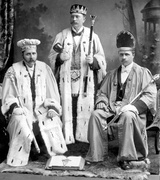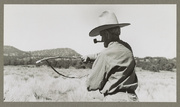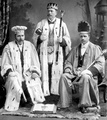
It’s tempting to dismiss the mid-16th-century depictions of Biblical miracles, flaming comets, multi-headed beasts, and apocalyptic chaos that fill the pages of the “Augsburg Book of Miraculous Signs” as the superstitious vestiges of the post-Medieval mind. But according to the co-authors of Taschen’s new, 568-page boxed volume called “Book of Miracles,” the Protestant citizens of Augsburg, Germany, were enthusiastic and active collectors of portrayals of portentous signs, as well as written descriptions of ancient and astrological prophecies. Gathering the myriad broadsheets and pamphlets about the imminent apocalypse into so-called Books of Wonders, of which the privately commissioned “Augsburg Book of Miraculous Signs” is probably the most important surviving example, was a way for people to connect the dots between ancient prophecies, their contemporary fears, and unexplainable phenomena, especially in the skies.
“Broadsheets were the Buzzfeeds of their day.”
In part, their passion stemmed from a collector’s fascination with such topics, but Germany’s 16th-century Protestants were also motivated by religious antipathy toward the Catholic Church, whose Pope they derided as the Antichrist. Some took the epithet for fact: For them, since the end was nigh, it behooved one to pay attention to the signs.
As Joshua Waterman of the Germanisches Nationalmuseum in Nuremberg writes in the Taschen book, which includes a facsimile of the circa-1552 gouaches and watercolors in the Augsburg manuscript, “The late fifteenth century had witnessed a surge of interest in miraculous signs which steadily increased in the decades that followed, ultimately reaching a high point toward the end of the sixteenth century, especially in Protestant territories. This development coincided with the rise of illustrated broadsheets and printed pamphlets as news media that spread reports of prodigies and portents, and with the religious and political upheavals of the Protestant Reformation, which fostered special concern for signs of God’s wrath and the coming end of days.”

Above: The depiction of the Tiber monster, which is said to have washed up on the banks of the Tiber river in Rome after a flood in 1496, has at least two contemporary sources. Top: “Miracles” ends with about 20 pages taken from the Book of Revelation, including chapter 13, verses 1-4.
“That doesn’t mean all people literally believed in all of the events described in the broadsheets,” adds Till-Holger Borchert, who’s the chief curator at the Groeningemuseum in Bruges, Belgium, and contributed an essay of his own to the Taschen publication. “But they did collect them.”
One such collector, whose identity remains unknown, commissioned the “Augsburg Book of Miraculous Signs.” “I would argue that this particular collection of superstitious images was very much based on scholarly and scientific curiosity,” Borchert says.
The Augsburg document is very much a product of the mid-16th century, which Borchert calls, “a period of great ambivalence. The next step would have been to create studies of things like comets, to look at them in a systematic way,” he says. But the Augsburg document preceded Galileo’s investigation of comets by more than half a century. “This was a step before that, and doesn’t seem to have been the primary interest of the guy who collected this material. But given his rather encyclopedic interest in celestial phenomena, it at least indicates an interest that transcended pure superstition to a more advanced level of perception.”

A miracle from Exodus 16:14-16: “And when the dew had gone up, there was on the face of the wilderness a fine, flake-like thing, fine as frost on the ground. When the people of Israel saw it, they said to one another, “What is it?” For they did not know what it was. And Moses said to them, “It is the bread that the LORD has given you to eat. This is what the LORD has commanded: ‘Gather of it, each one of you, as much as he can eat. You shall each take an omer, according to the number of the persons that each of you has in his tent.”
The presence of so much printed paper in Augsburg was also not accidental. The city was a printing center, located just a few hundred miles south of Mainz, where Johannes Gutenberg invented the printing press in the mid-15th century. Broadsheets were the Buzzfeeds of their day, featuring woodcut artwork and sensationalist headlines and text designed to capture the imagination of the common man.
The Augsburg book differs from the more common, almost scrapbook-like Books of Wonders in a number of key ways. First, it was commissioned from scratch rather than collected and amassed, although by whom we will probably never know. Second, while many of the images in “The Book of Miracles” were based on broadsheets and artwork by the likes of Hans Holbein the Younger and Albrecht Dürer, each page in the book was executed by hand, in colorful gouache and watercolor.
After much research, which includes matching watermarks on the original book’s handmade paper pages to those prevalent in Augsburg at the time, Borchert believes that the 16th-century artists who executed the original manuscript were Hans Burgkmair the Younger, Heinrich Vogtherr the Younger, and an unknown number of apprentices, a standard practice of the period. To its credit, Taschen has reproduced these plates at virtually full size (9 1/2 by 13 1/2 inches), including the backs of each piece of paper, smudge marks and all, exactly as in the original manuscript. Only two sheets of the original 160-plus images are unaccounted for.

“In the land of the Romans in the year 73 B.C., a golden ball was seen in the sky, which then came down to the Earth and rolled about and flew back up into the air again, in the direction of the rising sun, so that its great size covered up the sun completely. This was followed by the great Roman war.”
Considering that the volume probably changed hands numerous times over the centuries and was re-bound in the 19th century, its relatively intact survival is itself something of a minor miracle. “It’s a binding of the late 19th century,” confirms Borchert. “Where it happened, who did it, and what happened to the leaves that were presumably removed at that point, we don’t have any idea. Remarkably enough, they managed to put the thing back more or less in order, which is more than you can say for most re-bindings. Usually when people take books apart, they’re not able to put them back in order. But that didn’t happen in this case. It’s a pretty spectacular and unique document.”
While the Taschen volume includes Waterman’s and Borchert’s essays, as well as a complete transcription of the German text below each image, the original began with no preface, introduction, or even a table of contents. It went straight into a selection of miracles and signs of God from the Old Testament, beginning with the story of Noah’s Ark, which bobs beneath a pounding rain on a roiling blue sea littered with animals and humans, all swimming futilely for their lives. According to Borchert, the German text is the same as a 1545 version of Martin Luther’s translation of the Bible, which means this page, at least, is no older than that.

The “Book of Miracles” includes 26 examples of comets, including this one: “In the year 1007 A.D., a wondrous comet appeared. It gave off fire and flames in all directions. As it fell to Earth it was seen in Germany and Italy.”
On the pages that follow, we see Lot’s wife turned to a pillar of salt as Sodom and Gomorrah burn in the background, Moses parting the Red Sea, and a shower of manna from heaven, which Borchert says was probably an edible algae called crustose lichen, which grows on rocks and is sometimes lifted aloft by the wind. After the Bible stories, the book shifts gears to focus on miraculous signs from antiquity to the 16th century. Chief among these are numerous celestial apparitions, which had long been looked upon with trepidation by those tethered to Earth. We see the three suns that rose in the Roman dawn following the murder of Julius Caesar—we now call this phenomenon parhelia, or mock suns, which occurs when images of the sun are refracted in ice crystals suspended in the atmosphere. Elsewhere, there are no less than 26 examples of comets, which blaze across the pages of the book in brilliant yellows and gold. On other pages, volcanoes spew lava, fire rains down on crippled cities, and floods inundate once pastoral landscapes. This, we can’t help but think, is what the wrath of God must look like.
And then there are the beasts: Especially captivating is the Tiber monster, an anti-Catholic symbol favored by Martin Luther himself, consisting of the torso of a woman, the head of an ass, a cloven hoof in the place of its right foot, a claw on its left, and so on. Helpfully, the authors provide two examples of sources for the creature (see images above), engaging in a kind of artistic forensics using data that’s almost 500 years old.

“In the year 1009 A.D., the sun went dark and the moon was seen all blood-red and a great earthquake struck and there fell from the sky with a loud and crashing noise a huge burning torch like a column or a tower. This was followed by the death of many people and famine throughout Germany and Italy. More people died than remained alive.”
Yet despite the passage of time and the particular nature of the Catholic-Protestant polarization that drew the good citizens of Augsburg to these images, the historic pages reproduced in “Book of Miracles” appear fresh, almost contemporary. “The pictorial language,” says Borchert, “is surprisingly modern in its feel. The colors are sophisticated and strong, depicting catastrophes in an archetypal way that speak to us even after 500 years. It’s very understandable and clear.”
Indeed, one can easily imagine more recent catastrophes getting the “Book of Miracles” treatment, from people clinging to their rooftops in the aftermath of Hurricane Katrina in 2005 to scenes of almost Biblical devastation following the tsunami generated by the Tohoku earthquake in 2011. In the end, from the vantage point of 2014, that may be the real message of “Book of Miracles,” that the veneer of civilization we place our faith in daily is actually rather fragile and thin. “At this point,” concurs Borchert, “all it would take is a global disruption of electricity for about a month and we’d all be back in caves.”
More Images from the “Book of Miracles”
(All images via Taschen If you buy something through a link in this article, Collectors Weekly may get a share of the sale. Learn more.)











 Diablitos in the Details: The Curious Tale of Mexico's Most Peculiar Pottery
Diablitos in the Details: The Curious Tale of Mexico's Most Peculiar Pottery
 Decoding Secret Societies: What Are All Those Old Boys' Clubs Hiding?
Decoding Secret Societies: What Are All Those Old Boys' Clubs Hiding? Diablitos in the Details: The Curious Tale of Mexico's Most Peculiar Pottery
Diablitos in the Details: The Curious Tale of Mexico's Most Peculiar Pottery Our Dad, the Water Witch of Wyoming
Our Dad, the Water Witch of Wyoming Art and Design BooksLarge-format coffee-table books, which are meant to be shown off rather tha…
Art and Design BooksLarge-format coffee-table books, which are meant to be shown off rather tha… BiblesAs the most widely read book in Western civilization, the Bible offers a va…
BiblesAs the most widely read book in Western civilization, the Bible offers a va… DrawingsThere’s an immediacy to drawings that is not always present in paintings on…
DrawingsThere’s an immediacy to drawings that is not always present in paintings on… BooksThere's a richness to antique books that transcends their status as one of …
BooksThere's a richness to antique books that transcends their status as one of … Mari Tepper: Laying it on the Line
Mari Tepper: Laying it on the Line Nice Ice: Valerie Hammond on the Genteel Charm of Vintage Canadian Costume Jewelry
Nice Ice: Valerie Hammond on the Genteel Charm of Vintage Canadian Costume Jewelry How Jim Heimann Got Crazy for California Architecture
How Jim Heimann Got Crazy for California Architecture Modernist Man: Jock Peters May Be the Most Influential Architect You've Never Heard Of
Modernist Man: Jock Peters May Be the Most Influential Architect You've Never Heard Of Meet Cute: Were Kokeshi Dolls the Models for Hello Kitty, Pokemon, and Be@rbrick?
Meet Cute: Were Kokeshi Dolls the Models for Hello Kitty, Pokemon, and Be@rbrick? When the King of Comedy Posters Set His Surreal Sights on the World of Rock 'n' Roll
When the King of Comedy Posters Set His Surreal Sights on the World of Rock 'n' Roll How One Artist Makes New Art From Old Coloring Books and Found Photos
How One Artist Makes New Art From Old Coloring Books and Found Photos Say Cheese! How Bad Photography Has Changed Our Definition of Good Pictures
Say Cheese! How Bad Photography Has Changed Our Definition of Good Pictures Middle Earthenware: One Family's Quest to Reclaim Its Place in British Pottery History
Middle Earthenware: One Family's Quest to Reclaim Its Place in British Pottery History Fancy Fowl: How an Evil Sea Captain and a Beloved Queen Made the World Crave KFC
Fancy Fowl: How an Evil Sea Captain and a Beloved Queen Made the World Crave KFC
The one of Lot’s wife is especially striking. She’s standing right there against the burning red city, and Lot’s daughters are already getting him drunk in the cave, in the corner.